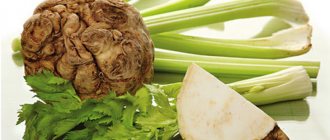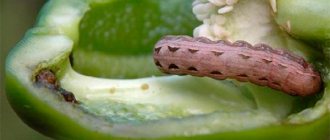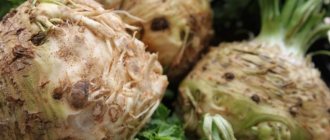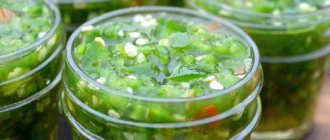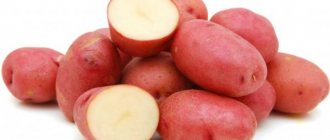Celery is a spicy vegetable that was brought to Russia from Mediterranean countries. Due to the content of a large amount of nutrients and vitamins, celery is considered a leader in terms of benefits among other vegetable crops. Essential oils, which are also included in its composition, give dishes a special aroma and rich taste. Every part of the plant, from root to leaves, is eaten. Raw celery, like processed celery, is tasty and healthy.
We will tell you how to properly clean the plant, store and use it.
What are the benefits of celery?
Before we study the methods of processing and consuming celery, let’s look at the reason for its popularity. A biennial aromatic plant forms a root crop in the first year, in the second year a flower stem develops from it and seeds ripen.
The plant stimulates appetite and has powerful antimicrobial, anti-inflammatory and choleretic effects.
It stimulates the activity of the kidneys, improves the separation of digestive juices, has a mild laxative effect, and increases blood supply to the genitals. Table of the chemical composition of celery (per 100 g of product)
| Vitamins | |
| Vitamin PP | 0.4 mg |
| Beta carotene | 4.5 mg |
| Vitamin A (retinol equivalent) | 750 mcg |
| Vitamin B1 (thiamine) | 0.02 mg |
| Vitamin B2 (riboflavin) | 0.1 mg |
| Vitamin B6 (pyridoxine) | 0.08 mg |
| Vitamin B9 (folic acid) | 21 mcg |
| Vitamin C | 38 mg |
| Vitamin E (tocopherol) | 0.5 mg |
| Vitamin PP (niacin equivalent) | 0.5 mg |
| Macronutrients | |
| Calcium | 72 mg |
| Magnesium | 50 mg |
| Sodium | 200 mg |
| Potassium | 430 mg |
| Phosphorus | 77 mg |
| Microelements | |
| Iron | 1.3 mg |
| The nutritional value | |
| Calorie content | 13 kcal |
| Squirrels | 0.9 g |
| Fats | 0.1 g |
| Carbohydrates | 2.1 g |
| Alimentary fiber | 1.8 g |
| Water | 94 g |
| Starch | 0.1 g |
| Ash | 1 g |
| Organic acids | 0.1 g |
| Mono- and disaccharides | 2 g |
Do I need to peel celery?
Celery can be leaf, petiole and root. And all these parts of the plant are eaten.
The leaves are added to food as a vitamin-rich green, along with parsley and dill. If the leaf part of the vegetable does not need to be further peeled, then housewives have questions about the root and petiole parts.
The stem is used to make juice, fresh salads and stews. It is recommended to peel it, because if the peel is thick, it can add bitterness to the dish.
Celery root looks similar to a turnip. Complex dishes are prepared with it: soups, sauces, roasts, salads. This part of the plant must be cleaned before cooking.
Caring for celery during tuber growth
When the young plants take root and grow a little, the celery will develop new leaves. The time has come to remove excess roots from grown plants. At this stage of development, I unplant the root celery, while cutting off all the roots that are located horizontally. I will do this technique again. It is better to trim off unnecessary celery roots with a knife.
And remember - root celery should never be hilled! Therefore, when loosening plants during care, I try not to add soil to the roots.
How to peel and cut celery
Celery is easy to process: the leaves are washed, the roots are cleared of the upper layers, and the stems are peeled only if they have a thick peel.
Roots
Cleaning the root is not much more difficult than processing carrots or turnips:
- Wash thoroughly under running water.
- Cut off the top and bottom parts with a sharp knife.
- Cut into several parts.
- Peel with a knife or vegetable peeler.
- Remove dark stains to white fiber.
- Cut out the spongy part of the rhizome (it is tasteless and there is no point in leaving it).
- Wash the peeled root thoroughly again.
- Cut into strips or cubes.
- To prevent it from darkening, fill it with water.
Stems
It is enough to wash the young petioles thoroughly; they do not need cleaning. They are distinguished from old ones by their bright green and fresh leaves.
Old petioles contain hard fibers that are bitter and can spoil the taste of the dish.
To clean a plant:
- Separate the stems from the base.
- Wash thoroughly.
- Using a knife (ordinary or for peeling vegetables), remove the hard fibers located on the surface.
Leaves
The leaves are used to season soups, salads or as a decoration for dishes along with parsley and dill. Therefore, they are simply washed.
How to cut
Typically, peeled celery root and stalks are chopped into strips or cubes. You can also grate it. And the leaves are finely chopped, like regular greens, or torn by hand.
How to peel stem and petiole celery: how to do it correctly, photo, video
Celery is used in cooking as often as parsley or dill. Its leaves and stems contain vitamins and essential oils that the body needs. However, the plant has not gained popularity among housewives, so not everyone knows whether celery needs to be peeled before use. Everything is clear with the leaves of greenery, but what to do with the stems is not entirely clear.
Do I need to peel celery?
Opinions differ on this matter. Some chefs advise eating unpeeled vegetables, while others insist that the stems must be peeled. Oddly enough, everyone is right. It depends on what kind of celery you purchased.
Do I need to peel stalk celery before eating?
Stem or root celery is famous for its root vegetable, which is eaten. The stems and leaves of such celery are not eaten. Root vegetables need to be peeled before eating. It is used to prepare soups, fresh salads and other dishes.
To make it easier to clean the root, you need to choose it correctly:
- the root crop must be large;
- the skin is smooth;
- nodes – minimum number;
- the leaves are green at the top.
This is the kind of plant that can be cleaned with a minimum amount of waste.
Attention! The fresh root has a distinct aroma. And the old plant has an umbrella with seeds, its taste will be bitter.
Petiole celery needs to be peeled if it is old. The fibers of such a plant are tough and not so pleasant to eat. But the young shoots are not cleaned; it is enough to rinse them under running water and they can already be eaten.
When choosing petiole celery, you need to pay attention to the shoots, which should be bright green, juicy, crispy, and without visible damage. If the base is already missing several leaves, and the shoots have a brownish tint, then the greens are stale. It is better to refuse such a purchase. After all, it is the petioles that contain the necessary essential oils.
Important! Young shoots are brightly colored and grow inside the bunch.
Each type of celery has its own cleaning methods. Therefore, you first need to determine which part will be eaten.
How to peel stalk celery
In this type of vegetable, the thickened lower part of the stem or modified root is used for food. Before preparing the salad, stem celery must be properly peeled:
- Carefully remove any remaining soil from the root, then rinse under running water.
- Cut off the top and bottom parts of the root vegetable with a knife.
- Divide the vegetable into several parts, peel only the desired piece, and put the rest in the refrigerator.
- Peel the skin using a special knife or vegetable peeler.
- Cut out any damaged areas or dark spots. After peeling, only white pulp should remain.
- Rinse the peeled root under the tap, then fill it with water so that it does not darken.
After cleaning, the coarse part of the pulp is used to prepare soups or broths. It contains a lot of fibers that are good at removing toxins and waste from the body, but have no taste. For cooking, the soft part is cut into cubes, strips, slices or grated.
Advice! The coarse part of the pulp is suitable for preparing various dishes for weight loss.
Peeling stalked celery is easy. To do this, you will need a regular paring knife.
Instructions for peeling celery stalks before eating:
- Separate the bunch into individual petioles.
- Rinse the greens well under the tap in warm water.
- Cut off the lower part of the shoot, which held the petioles together by 2 cm.
- Peel the top of the shoot with a vegetable peeler, along with any coarse fibers and veins.
After cleaning, the petioles are cut into cubes or strips. They are used to prepare fresh dietary dishes, pickles, and marinades. The delicate petioles give food an aroma and spicy taste.
How to Peel Leaf Celery
The most flavorful type is leaf celery. Its tender greens are rich in vitamins and microelements. The petioles and tubers of this variety are unsuitable for food, as they are coarse and thin. Greens have a sharp ethereal aroma.
How to peel celery leaves:
- Cut off all petioles and roots.
- Remove dry, yellow or limp leaves.
- Wash the greens thoroughly and chop them with a sharp knife.
Greens are used to prepare sauces, decorate salads or other dishes.
When choosing leaf celery, you need to pay attention to its appearance. Greens should be juicy, elastic, aromatic. If the leaves in a bunch are limp, then they have been lying there for a long time.
Warning! It is better to put chopped herbs in the sauce, so the juice will mix faster with other ingredients. Whole leaves reveal flavor as you eat.
Properly peeling stalk celery is not enough to enjoy its taste; you need to know how to cook the vegetable. The root is simmered until tender, covered, until it becomes soft. The color of the finished vegetable changes from white to a light cream shade.
You can store the peeled and cut into pieces root for a short time in the refrigerator. Like all products, the pulp loses its beneficial properties, fades and becomes weathered. Vegetables cannot be kept in a bag; this does not increase the shelf life.
The freshness of petiole celery lasts for about a week. Store it in the refrigerator, well wrapped in foil. This species is most valuable when it is fresh. After heat treatment, most of the useful components disappear.
However, not everyone can eat celery. The vegetable is prohibited if the following pathologies are present:
- stomach or duodenal ulcer;
- gastritis in the acute stage;
- phlebeurysm;
- urolithiasis disease;
- risk of thrombophlebitis.
In addition, the product is strictly contraindicated for pregnant women and nursing mothers, since its effect on the fetus has not been studied.
Nutritionists recommend consuming no more than 150 g of celery per day so as not to harm the body. If you follow these tips, the vegetable will only bring benefits:
- The aging process of cells slows down.
- The water-salt balance in the body is restored.
- Blood pressure normalizes and blood flow improves.
- Brain activity increases and irritability decreases.
- The immune system is strengthened, which is important during the cold season.
- Resistance to stress appears.
- The kidneys and ureters are cleansed.
- Blood sugar levels decrease.
- Stool normalizes and constipation disappears.
- Heartburn goes away.
- Weight is normalized.
- Vision improves.
Among other things, the body is saturated with vitamins and minerals. So eating greens in moderation will not harm your health.
How long can celery be stored and how to prepare it for the winter
A healthy vegetable can not always be found on store shelves, especially in small towns. Therefore, it is useful to learn how to prepare it for long-term storage.
To store the root crop, it must be cleaned as follows:
- the leaves are cut off, leaving only small petioles;
- sand is poured into the box, the root crops are placed with the petioles facing up;
- Store celery in a basement or cold room.
You can save the root vegetable in dried form. To do this, you need to clean it, chop it into strips and dry it. Then place in a glass container with a tight-fitting lid.
Celery greens wither very quickly, so it is better to dry them and use them for their intended purpose at any time of the year. To do this, the leaves are prepared, laid out on paper and dried for a month. Dried herbs should be stored in paper bags.
You can preserve petiole celery by freezing it. Peel the shoots, chop and place in 1 layer on a cutting board. After this, place in the freezer. When the pieces are frozen, they are poured into a plastic storage container or bag. Use the workpiece without prior defrosting.
Conclusion
Peeling and cooking celery is a snap. The vegetable deserves attention, as it is rich in vitamins and other beneficial substances. Plus, it's easy to save. Celery can be dried, frozen, or stored fresh.
Source: https://fermilon.ru/sad-i-ogorod/zelen/kak-ochistit-selderey.html
Processing methods
Celery is eaten both raw and as part of dishes. During heat treatment, the plant loses some of its beneficial properties.
The root is eaten raw, added to salads and cold soups. It is also boiled, fried, stewed, baked, marinated as a seasoning in main vegetable and meat dishes, soups and winter preparations.
The leaves are eaten fresh, dried, pickled and used as a seasoning.
The petioles are most often eaten raw, as part of freshly squeezed juices, smoothies and salads. They, like the root, are also added to many dishes.
What can you cook
Most often, the plant in question is used as a seasoning or added to a salad, so users are more interested in how to beautifully cut celery. However, in addition to this method of use, there are many more recipes in which the vegetable in question acts as a full-fledged independent product.
From stalk celery
From stem varieties you can prepare:
- stew with a mixture of various vegetables;
- petioles fried in batter;
- beetroot soup with celery - in this dish beets and celery are taken in equal proportions;
- creamy soup;
- vegetable smoothie - celery stalks, carrots and tomatoes are mixed in equal proportions in a blender;
- stems stuffed with shrimp or trout;
- cocktails in which the main ingredient is combined with various vegetables and fruits at your discretion;
- caviar;
- celery-mushroom sauce;
- cheese casserole with petioles.
The stems can be combined in salads with a wide variety of ingredients. The most interesting culinary delights are obtained when combined with:
- mushrooms;
- turkey meat;
- tuna;
- fennel;
- cheese;
- cottage cheese;
- apples;
- Chinese cabbage;
- carrots.
From the root
From root varieties you can prepare:
- root baked with port;
- cream soup;
- soup with pear, blue cheese and diced root;
- root baked with parsnips and apples;
- puree with spices and garlic;
- fortified cocktail.
Terms and conditions of storage
Celery cannot be stored for long, so it is recommended to buy it fresh. Shelf life depends on storage conditions and averages from 3 to 10 days.
In the refrigerator or cool cellar
Shelf life is from 7 to 15 days.
The vegetables are washed and dried with a paper towel. Then wrap it in cling film or foil or put it in a plastic bag or plastic container and put it in the refrigerator.
You can only store intact celery, without limp leaves or chopped stems. Otherwise it will go bad in a matter of days.
There are also ways to preserve root vegetables for up to two months:
- Stick the roots vertically into dry sand poured into a box or box. The petioles are left on the surface. A box of sand is stored in a basement or cellar.
- Root crops are placed in plastic bags, sprinkled with a layer of sand (2 cm), placed in a room with a temperature no higher than +1°C and a humidity of approximately 90%.
- The clay is diluted with water to a creamy substance. The root crop is covered with a layer of clay, dried and placed in rows in cool storage.
In the freezer
Shelf life – from 6 to 12 months.
It is recommended to store celery in small portions because it cannot be frozen several times.
The following methods exist:
- Cut into small pieces. Freeze in a bag or container. This is how, for example, dressing for dishes is prepared in advance.
- Grind using a blender or meat grinder. Ice trays are filled with the resulting mixture and placed in the freezer.
- The vegetable is frozen without chopping.
Leaf and petiole celery can be frozen whole: the stems with leaves are placed in a tightly closed container and placed in the freezer.
Celery root is also frozen. To do this, it is cut or grated, then packaged in small plastic bags.
At room temperature
Shelf life is from 2 to 3 days.
The longer celery is kept warm, the faster it loses its beneficial properties, taste and appearance. Therefore, you can store it at room temperature if you find a use for it in the near future.
For better preservation:
- Place the vegetable in the jar.
- Fill halfway with cold water.
- Place in a cool, dark place.
- The water is changed daily.
Dried
Shelf life – from 8 to 12 months.
All parts of the plant are suitable for drying.
Algorithm for preparing for drying:
- Rinse thoroughly.
- Remove dirt and skin if necessary.
- Slice thinly.
- Place on a baking sheet or tray.
- Place in a dry, cool place for 30-40 days, or in an oven or electric dryer for 4-6 hours.
- Then transfer it to a paper bag, fabric bag or glass jar.
Salted
Celery that has been salted can be stored all winter, because salt is a natural preservative.
Salting leaf celery is done as follows:
- 0.5 kg of plants are chopped or crushed using a meat grinder.
- Add 100 g of salt and mix.
- Add currant leaves or horseradish to taste.
- The mixture is filled into a clean container.
- Store salted celery at a temperature of +5...+7°C.
Celery dishes
Let's look at a few simple recipes for cooking celery.
Puree
Celery puree is a tasty and at the same time healthy side dish with a pleasant creamy consistency. It cooks quickly and can be an excellent alternative to traditional mashed potatoes.
Ingredients:
- celery root (medium) – half;
- potatoes – 1 pc.;
- garlic – 2 cloves;
- milk – 1 l;
- butter – 50 g;
- bay leaf – 1 pc.;
- cheese (grated) – 1 tbsp. l.;
- salt and pepper to taste.
Preparation:
- Peel celery and potatoes and cut into small cubes.
- Place the vegetables in a small saucepan, add garlic and bay leaf, pour in milk so that all ingredients are completely covered.
- When the milk boils, reduce the heat. Continue cooking the vegetables for 15-20 minutes (until the celery and potatoes become soft).
- Strain everything through a sieve (but do not pour out the milk!). The bay leaf is thrown away.
- Butter, cheese, salt, pepper and the milk in which they were boiled are added to the vegetables.
- Mix in a blender until smooth. The puree should become creamy.
The side dish is ready. You can serve with meat, fish, poultry or other vegetables.
Pickled celery
Pickled celery is a unique dish in its benefits, which, thanks to the pickling process, is healthier than the fresh plant.
Ingredients:
- celery stalk – 6-7 pcs. medium size;
- water – 1.5 l;
- garlic – 4-5 cloves;
- ground chili pepper – 0.5 tsp;
- black pepper (peas) – 7-10 peas;
- lemon – 1 pc.;
- sugar – 2 tbsp. l.;
- salt – 2 tbsp. l.;
- parsley stem - 1 bunch.
Preparation:
- Peel the celery stalk and cut into small pieces.
- Peel the garlic and cut into thin strips.
- Place black pepper, garlic, parsley, and celery in one container. Season with ground chili pepper.
- Take 1.5 liters of water into a saucepan, add sugar and salt and bring to a boil.
- Squeeze the lemon juice and add it to the pan after boiling.
- Remove from heat.
- The resulting hot liquid is poured over celery and spices.
- Cover with a plate on top. To make it fall inside, they put pressure, for example, a jar half filled with water.
- Leave the celery to cool at room temperature.
- After everything has cooled down, put it in the refrigerator for three days.
Pickled celery is ready.
Salad
A fresh and juicy salad of celery, cucumbers, walnuts and green onions will diversify the menu and enrich the diet with vitamins and minerals.
Ingredients:
- stalk celery – 180 g;
- fresh cucumber – 190 g;
- walnuts – 25 g;
- green onion – 10 g;
- sour cream – 2 tbsp. l.;
- salt to taste.
Preparation:
- All vegetables are washed and peeled.
- The stems are cut into small pieces.
- The cucumber is first peeled so that it does not taste bitter. Cut into thin strips.
- Green onions are finely chopped.
- Add vegetables to one container and mix.
- Season the salad with sour cream.
- Walnut kernels are chopped and added to vegetables.
- Salt and mix again.
You can serve the salad immediately after preparation.
Soup
Not only snacks are prepared from celery, but also hot dishes, such as soup.
Ingredients:
- celery stalk – 1 pc.;
- potatoes – 4 pcs.;
- onion – 1 pc.;
- carrots – 1 pc.;
- tomatoes – 1 pc.;
- salt and vegetable oil to taste.
Preparation:
- All vegetables are washed and peeled.
- Potatoes are cut into cubes.
- Celery is divided into small pieces.
- Add everything to the pan, add water, salt and set to cook.
- Grate carrots on a coarse grater.
- Finely chop the onion.
- Cut the tomato as finely as possible.
- Add everything to the pan along with butter and simmer for about 10 minutes.
- Stewed vegetables are added to the pan and cooked until tender.
- The finished soup is pureed in a blender.
- Then pour it back into the pan and boil.
Before eating, the soup is decorated with sprigs of herbs or pine nuts.
Smoothie
One of the most popular smoothie combinations is carrots and celery. They not only saturate the body with useful substances, but also give energy throughout the day.
Ingredients:
- petiole celery – 2-3 stalks;
- carrots – 1 pc.;
- orange – 1 pc.;
- honey to taste.
Preparation:
- Grate the carrots on a fine grater.
- Celery stalks are cut into thin slices.
- Grind everything in a blender.
- Squeeze juice from orange.
- Add to blender along with honey.
- Stir.
The smoothie is ready. If the taste is still bitter, you can add more honey.
Peculiarities of processing celery root
Housewives most often have problems with this plant. Given the fact that it grows in the ground, you first need to get rid of traces of soil on the surface of the formation. This is one reason why it is better to purchase a smooth root rather than a knotty one. It is much easier to clean, and it is easier to cut off the skin.
The cleaning process for the product is as follows:
- We take a large knife and use it to cut off the skin from the upper and lower parts of the fruit.
- We cut off as much root as is needed to prepare the planned dish. We put the rest in the refrigerator. You don't have to use bags or cling film. They will not increase the shelf life.
- Using a knife or vegetable peeler, cut off the skin and spoiled areas from the prepared piece. There should not even be spots left on the pulp; we ensure its purity and uniformity.
- Particular attention should be paid to the structure of the root crop. It can be divided into spongy and main parts. The first consists of fibers that help cleanse the body, but it is absolutely tasteless. It is used to prepare soups and infusions during the detoxification period. The second one saturates dishes with vitamins and aroma, which is why it is most often used in cooking.
- Now we rinse the pulp again under cool water, cut it as needed according to the recipe. In general, the smaller the pieces, the more nutrients will get into the finished dish.
- If the workpiece will not be used immediately, it must be filled with cold water. Otherwise, within a few minutes it will begin to darken like potatoes.
Many people know how useful celery is and how its introduction into the diet will affect the condition of the body. Unfortunately, this knowledge very rarely encourages the use of the component in the process of preparing familiar dishes. This is usually due to the lack of skills in the field of pre-processing of the product. Violation of the rules for choosing and cleaning techniques for celery leads to the fact that it imparts an unpleasant bitterness or too strong aroma to the finished compositions.
We invite you to familiarize yourself with 100 to 1. Where are old things stored?
For cooking, you can use both the rhizome and stalks of celery. It can be added to salads, sauces, soups. Thanks to its fresh taste and high amount of fiber, this type of green is very beneficial for the body. If you've never used it in cooking before, check out our tips for preparing it properly.
Despite this, this plant is not very popular in our country, more and more people are including it in their diet. It can be used raw or processed, and is included in many recipes. If desired, you can freeze it in the freezer.
Celery rhizome is used as a natural spice because it has a tart flavor. As for the stems (they are also called petioles), they are added to salads, stews, and used to make snacks. You can also make a delicious juice or smoothie from the stems.
How to peel celery correctly? Before you eat it, you must prepare the root vegetable. First, rinse it and remove all dirt. Separate each stem and rinse it individually, place it on paper napkins or towels to absorb the water.
As for the greens, which are located on the top of the stems, they are used very rarely. Simply rinse them and chop them or add them whole to your dish if desired. You can add the leaves to salads and use them for decoration.
Check out our recipe for Creamy Potato and Celery Soup
